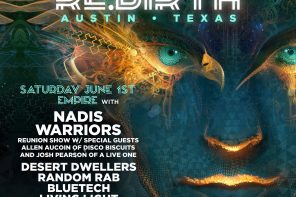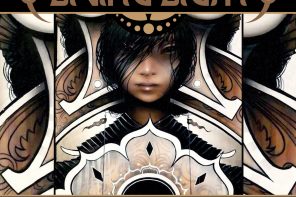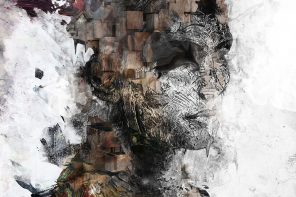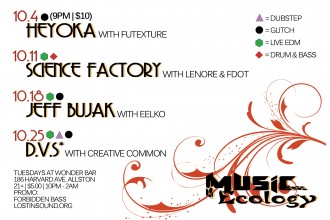This interview brought to you in partnership with The Bloom Series
Dela is an artist who is clearly inspired by the dream world. Within the subtle astral plane where the subconscious influences a self-created world, Dela begins to create his mixed-genre landscapes of animals, nature, nebulas, and the human condition that are sure to inspire lucidity within the viewer. As a ten year old kid moving from Mexico to Puerto Rico, Dela began experimenting with creative self-expression through drawing and painting after restless nights of self-induced delusion through sleep deprivation. Fast forward fifteen years – now Dela, a completely self-taught artist, can be regularly seen doing live painting at a variety of events all over the San Francisco Bay area. You may have already caught him at a transformational festival last year, such as Enchanted Forest, Lucidity, or Burning Man, collaborating with the artistic masterminds of Derek Heinemann, Seth McMahon, Randal Roberts, and Jonathan Solter, known conjointly as the artistic collective called The Union.
 If you’ve been walking around the Mission in San Francisco recently, you may have stumbled upon one of the cities newest murals, a collaboration by Dela and Max Ehrman that can be found at Sycamore & Valencia. With visual art influences from Leonardo Davinci, Salvador Dali, and Alex Grey and a strong interest in environmental issues, it’s clear that Dela is on a mission to blend the best techniques and styles of the art world to create art that tells the story we are currently living. His artivist stories hold both the beauty and the beast of humanity through cosmological splashes of nebulas spiraling through natural areas of devastation, like deforestation and polluted waters. Living out his artivist nature, Dela recently teamed up with Unify and SolPurpose for the Unify World Water Day campaign, contributing his image titled “Inspired” to a campaign that promotes “clean and pure water for all species on Earth.”
If you’ve been walking around the Mission in San Francisco recently, you may have stumbled upon one of the cities newest murals, a collaboration by Dela and Max Ehrman that can be found at Sycamore & Valencia. With visual art influences from Leonardo Davinci, Salvador Dali, and Alex Grey and a strong interest in environmental issues, it’s clear that Dela is on a mission to blend the best techniques and styles of the art world to create art that tells the story we are currently living. His artivist stories hold both the beauty and the beast of humanity through cosmological splashes of nebulas spiraling through natural areas of devastation, like deforestation and polluted waters. Living out his artivist nature, Dela recently teamed up with Unify and SolPurpose for the Unify World Water Day campaign, contributing his image titled “Inspired” to a campaign that promotes “clean and pure water for all species on Earth.”
In this interview Dela dives in to discuss the evolution of his art, his creative process and how it is influenced by music, the evolution of visionary art in transformational festival culture, what it takes to collaborate with others, and the future that lies ahead.
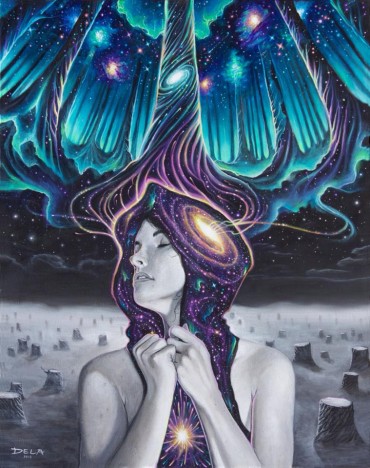
[LiS] I first met you in San Francisco at an outdoor arts market late in the summer of 2011. You were painting on these beautiful wooden slabs with animals as your main subjects. Can you tell us your story of how things have unfolded and evolved for you as an artist since you’ve moved to the Bay?
[Dela] My paintings back then were really bright with a lot of neon colors. When I was painting those slabs, I was painting in my studio and I remember making this one painting where there was a woman in the middle, and I painted everything around her except for her. The painting was really colorful, and I left her black and white to paint last. I stepped back and I was like, woah, she looks great just in white, so I added some grays to her face and her skin and I was like, “I’m just gonna go for this.” So then I did another one in the same style with black and white and neons and I just loved it. I realized there was something here and I wanted to try it out. As soon as I brought it out, people seemed to really dig it. I don’t really know where the black and white came from though. I think it comes from photography or black and white film or it could be the fog in San Francisco; I’ve never experienced anything like it.
Do you listen to music while you’re painting in the studio? If so, what are some of your favorites to jam out to?
Yeah, I usually do. Lately I’ve been listening to a lot of classical, more piano background music almost. I listen to so much music and I am really happy to be in a scene that is providing a lot of good tunes. I’ve been listening to a lot of Russ Liquid, Phutureprimitive, among others like Sigur Rós that is more like ambient music that doesn’t make me focus too much on the music, allowing me to focus on my thoughts. The music plays more of a background element for me in the studio.

What’s the experience like for you to creatively express yourself in a setting like a concert/festival versus working in your studio? How does the musical setting influence your artistic process?
I’ve always enjoyed the time alone in the studio by myself; I control the elements, and it’s easier for me to see the detail on a painting versus a live environment. You have to be in love with performing for other people doing live painting. I’ve learned to love painting live even more the more that I do it and the more that I travel. The only thing is that I have to polish the painting in the studio. I can’t do it live because of the light and because I’m inside a dark environment typically. I really prefer to paint outside in the sun but I like painting in both settings. Sometimes you need a break from the studio, and sometimes you need a break from the live painting.
As for the influence of the musical setting, for me, the more you enjoy the music, the more it shows in your work. Love and Light is someone I’ve really enjoyed painting to live. There have been other types of music that I don’t like, and I noticed a difference in the work that I create.
You mention how working on a mural in Florida was when you realized your passion for painting. Now you are part of an artist collective has been co-creating the artistic vibes at transformational festivals throughout the West Coast with The Union. Can you talk more about the process of painting a mural and how a painting is brought to life through collaboration?
It’s been really interesting, new, and challenging to paint with a group of people for a mural because everyone has their own idea, their own colors that they want to bring, and what they want to say. I think the best thing we’ve done is that we have a meeting before the festival, and we’ll drink some beers and sketch out some ideas on what we’re going to do so that everybody knows what part we’re going to execute when we get there. Another thing that I think we did right was the selection of artists [to join the collective]. Basically it was Derek Heinmann and Seth McMahon who started The Union, and then they chose me and another gentleman, Randal Roberts. What we did was plan out something like “we can put this part here, that’s Dela, we can put this part here, that’s another artist.” It’s challenging at times though. I would compare it to being in a band or something like that. You have a good idea and another person might not think it’s that good; it’s a balancing act between going forward and retreating, backing away from that idea and doing something else. It’s still to this day a learning process every time we paint together. We’re still learning a lot from each other, but you also have to quiet yourself sometimes. You know, maybe it’s the ego, maybe it’s not, but sometimes you just have back away and perform for the people.
Many festivals tend to favor a specific type of art, specifically visionary art. What are your thoughts on how the art scene will evolve along with the transformational festival culture?

I’ve noticed that some people have voiced complaints that a lot of the art is starting to look the same, especially with new comers who are starting to do the same kind of flower of life or sacred geometry sort of things, which I love if done correctly. I think it’s kind of ironic with this situation since it’s called “transformational festival” because the art has to transform and it has to keep changing and evolving. If the art is going to keep up with the concept of transformation, it needs to change from what it is right now. That is, the artists needs to believe in themselves, their own voice, and their own things that they want to say and it should be like nothing the world has ever seen before. That’s what makes the scene exciting is new things that are constantly coming through and showing themselves.
Do you have a favorite event? A “home” event?
I have to say Enchanted Forest last year was definitely my favorite. I also did another festival in South Carolina called Gratifly which was a little bit bigger than Enchanted Forest but it was very art related. You know, the East Coast is doing that thing right where it’s like equal music and equal art, and they treat everybody the same which is what I think we need a little bit more of on the West Coast. On the East Coast they fly you out there, feed you, they give you this, all this extra stuff, and they really make you feel like you’re a part of the whole festival. They’ll even put your names on the flyer and stuff, not just the headliners like Alex Gray and Amanda Sage; they will try to put all the 20 or so artists on the flyer.

I think it’s good to voice your opinion. We’re not getting a lot of love, you know – we’re out there performing for 3 days, sometimes 8 hours a day, while a DJ does a 45 minute set and they fly back. I mean, yeah, they brought the people but the art is really giving people an unique experience because they’re seeing a piece from the beginning to 85% done and as an artist, you want to give them something to remember. It was a piece of art that they were transformed by, and we were transformed by.
A lot of the times, there is an issue for the live artist to get their names on the flyers, and it’s because there are a ton of us but there are some of us that are starting to climb the ranks little by little, and I think it’s important that they are recognized as well. I keep applying to international festivals and I keep seeing the same three or four live artists that are going and painting and hitting them up. The scene is not going to flower and bloom from that, you got to give the other guys that are hustling just as hard a chance as well. I usually keep quiet about this stuff but I think it’s time…
Last year at Enchanted Forest, “the heart of The Union was formed” which gave birth to the epic masterpiece collaboration called “Enchanted.” For me, this title suggests that the subjects are under a magical influence. What sort of magical influences found their way through you as you co-created this piece?
You know, Enchanted Forest last year was really strange for me, strange in the most beautiful way. When I got there, I got really high and I turned really pale as soon as I drove in. I was driving around, and I was seeing how everybody was building and setting up in preparation the day before and something happened right there. Jonathan Solter was like, “are you alright, what’s going on? did you take anything?” and I was like, “dude, I don’t know, I’m just really ecstatic and like happy and like super high.”

This was the first festival that I didn’t take a single drop of alcohol or anything – nothing. Just raw organic food, water, and good sleep. I worked hard every morning. I remember just painting every morning, taking a break, and then coming back at night and painting all night long until the sun came up. What we painted was just five people coming together in the most perfect space. We talked about that painting, we came up with a simple woman and man kissing and just went from there. Everyone knew what they were doing, what kind of colors we were going to choose and stuff. Of course we had no idea that it was going to turn out like that, but it’s definitely the best thing we’ve ever done maybe we ever will. Something about Camp Navaro and those trees, sleeping 5-6 hours a day and feeling fully energized the next day… You could jump in the creek. It was something, I don’t know, it was just enchanted. We were all under some enchanted spell or something.
We did a festival the year before too, and it was fun but this one kind of locked it in. It was kind of like a big deal for me. I definitely felt like I was an artist, from California, from the Bay area, this is my family, these are my friends. It was all good vibes, there was never a weird vibe between the artists. There were a lot of artists there but this one solidified an inner knowing, like I really felt like I was a part of it and I belonged out here.
 In one of your most recent pieces, “Non Person,” you described this particular painting as an example of artivism, or using art as a way to raise social and environmental awareness. What sort of social and/or environmental issues can we expect to see in future work?
In one of your most recent pieces, “Non Person,” you described this particular painting as an example of artivism, or using art as a way to raise social and environmental awareness. What sort of social and/or environmental issues can we expect to see in future work?
I think I’m going continue the environmental awareness messages and themes in my paintings. Sea Shepherd headquarters from Seattle just called me, and they’re in love with the art and they want to use it in a way to fund them or do a benefit. I’m in talks with them; I’m not sure where it’s going right now but it’s definitely something I want to support. Sea Shepherd is basically protecting whales and dolphins in a lot of parts of the world. They are one of the only organizations that are physically taking action against a lot the Chinese whaling boats and stuff. One of the reasons I named the dolphin piece “non-persons” (technically non-human persons is the right title) is because India just declared dolphins that name. Dolphins are just extremely magical, and I don’t think we really know anything about them. They are extremely intelligent, and I wanted to honor and acknowledge these special creatures.
Besides the Visionary Art movement, are there any other movements that you feel a part of?
I think that my work is one where you don’t have to be in the visionary or transformational festival culture to understand it. I think that there are other sub-genres that my art can fit into. I consider my art visionary but I also think it is surrealist – there’s something impressionism going on in there. I’m definitely trying to mix as many of my favorite things in my paintings. There are things like the classical female form with hubble telescope photography, with black and white film, and near-extinction animals, so there’s the environmental thing as well.
Artivism is a word that I just kind of heard about two months ago, but I saw a lot of art and I thought I could definitely put my paintings with these guys and not just be in one genre. I think we’ve done everything there is to do in film and art, I mean there is still going to be new things, but I like the idea of mixing the genres to create something new. I normally wouldn’t call my stuff visionary art but I’m very glad for Alex Grey. If it was for him and his book The Visionary Art of Alex Grey, this art wouldn’t have a name, or an identity that makes it the community that it is.
What lies ahead for Dela in the future?
I’m definitely going to keep pushing my art and I’m going to keep trying to get to the international level this year. I’d like to try to make it to Boom Festival this year, and I’m definitely going to Mexico. I am in the works of planning a solo show in San Francisco and I actually just finalized the date – it’s Friday, April 25th at Inner Mission SF (previously called Cell Space) which is at 2050 Bryan St. in the Mission. It’s going to be way bigger than last year’s solo show that I had for my first year in the city; I’m going to have entertainment, installations, and interactive art. It’s definitely going to be a good time so I’m looking forward to having everyone come out!













